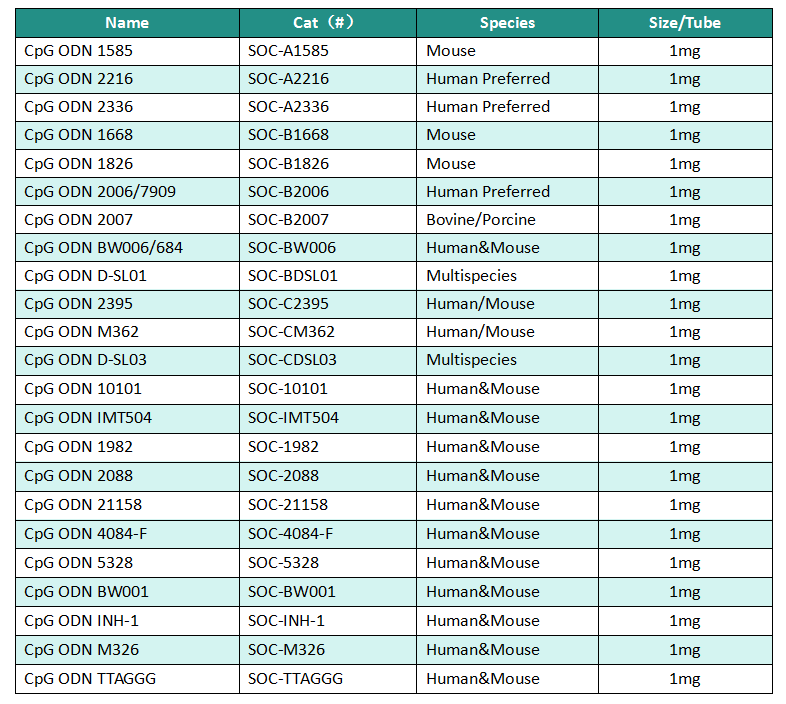CpG ODNs are a kind of oligodeoxynucleotide (ODN) containing unmethylated cytosine guanine dinucleotide, which is in the form of single stranded DNA and is an agonist of Toll like receptor 9 (TLR9). TLR9 plays an important role in the innate immune system and acts as a bridge between innate immunity and adaptive immunity in antitumor response. Studies have shown that treatment with chemically synthesized CpG ODNs can lead to tumor regression because B-cell malignancies express TLR9 and respond directly to CpG ODNs.
The Role of CpG ODNs in the Regulation of the Immune System
CpG ODNs directly stimulate plasmacytoid dendritic cells (pDCs) and B cells. For example, CpG ODNs induce the maturation of pDCs by up-regulating MHC and costimulatory molecules and secretion of cytokines and chemokines. This enhances the ability to stimulate T cells, including promoting T cell survival and memory, enhancing the cytotoxicity of CD8+ T cells, and activating CD4+ T cells. CpG ODNs can also promote B cell proliferation and plasma cell differentiation. In addition, TLR9 stimulation in B cells increase the secretion of cytokines such as IL-6 and IL-10.
Classification and Characteristics of CpG ODNs
Different types of CpG ODNs have different structural characteristics and immune effects. They are generally divided into three types: Class A, Class B, and Class C. The structures, functions, and applications of each type of CpG ODN are summarized as follows:
| Types | Structures | Functions | Applications |
|---|---|---|---|
| Class A | It has a palindromic sequence containing CpG dinucleotide as its core, poly G tails at both ends, and partial phosphorothioated modifications on the phosphodiester bond skeleton. | It can activate plasmocytoid dendritic cells and induce many type I interferons, which has weak activity against B cells. | Antitumor and antiviral immune adjuvants in the treatment of immune deficiency diseases. |
| Class B | It is a type of linear CpG ODN modified with full phosphorothioates. | It has strong immunostimulatory activity on B cells, but cannot activate plasmocytoid dendritic cells. | Subunit vaccine, DNA vaccine and other vaccine adjuvants. |
| Class C | It is a type of CpG ODN modified with full phosphorothioates. It can form a dimer through the palindromic sequence, and have the activity of Class A and Class B CpG ODNs. | It can activate both plasmocytoid dendritic cells and B cells. | Autoimmune disease stimulant |
Species Specificity of CpG ODNs
CpG ODNs have species specificity in certain species. Researchers are continuing to explore CpG ODN sequences that play a role in different species. For example, previous experiments have shown that the following sequences have strong stimulating activity to corresponding species:
| Species Type | CpG ODN Sequence |
|---|---|
| Pig |
5’-TCCATGACGTTCCTGACGTT-3’ 5’-ATCGATATCGAT-3’ 5’-GACGTTGACGTT-3’ |
| Cow |
5’-TCGTCGTTGTCGTTTTGTCGTT-3’ 5’-TCGTCGTTTTGTCGTTTGTCGTT-3’ 5’-TCGTCGTTTTGTCGTTTTGTCGTT-3’ |
| chicken | 5’-TCGTCGTTTTGTCGTTTTGTCGTT-3’ |
| Dog | 5’-GGTGCATCGATGCAGGGGGG-3’ |
| Shrimp | 5’-TCGTCGTTTTCGGCGCGCGCCG-3’ |
| … | |
Synbio Technologies’s CpG ODN Spot Products and Customized Services
Based on our Syno® synthesis platform, Synbio Technologies can provide three different types of CpG ODN spot products: Class A, Class B, and Class C. We can also customize the synthesis of CpG ODN sequences with various modification types according to the needs of customers.
Competitive Advantages
• Large spot supply
• High purity guarantee
• Low endotoxin
• Aseptic preparation
Service Specifications

References
[1]Ling Bai, Wei Chen, et al. Heterogeneity of Toll-like receptor 9 signaling in B cell malignancies and its potential therapeutic application. Journal of Translational Medicine. 2017.15:51.
[2]. Ballas ZK. et al., 2001. Divergent therapeutic and immunologic effects of oligodeoxynucleotides with distinct CpG motifs. J Immunol. 167(9):4878-86.
[3]Julia Scheiermann and Dennis M. Klinman. Clinical evaluation of CpG oligonucleotides as adjuvants for vaccines targeting infectious diseases and cancer. Vaccine. 2014. 32(48): 6377–6389.
 DNA Synthesis
DNA Synthesis Vector Selection
Vector Selection Molecular Biology
Molecular Biology Oligo Synthesis
Oligo Synthesis RNA Synthesis
RNA Synthesis Variant Libraries
Variant Libraries Genome KO Library
Genome KO Library Oligo Pools
Oligo Pools Virus Packaging
Virus Packaging Gene Editing
Gene Editing Protein Expression
Protein Expression Antibody Services
Antibody Services Peptide Services
Peptide Services DNA Data Storage
DNA Data Storage Standard Oligo
Standard Oligo Standard Genome KO Libraries
Standard Genome KO Libraries Standard Genome Editing Plasmid
Standard Genome Editing Plasmid ProXpress
ProXpress Protein Products
Protein Products
























